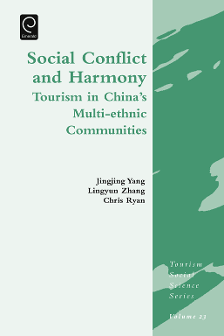
Preface
Social Conflict and Harmony: Tourism in China’s Multi-Ethnic Communities
ISBN: 978-1-78441-356-9, eISBN: 978-1-78441-355-2
ISSN: 1571-5043
Publication date: 6 June 2016
Citation
Yang, J., Ryan, C. and Zhang, L. (2016), "Preface", Social Conflict and Harmony: Tourism in China’s Multi-Ethnic Communities (Tourism Social Science Series, Vol. 23), Emerald Group Publishing Limited, Leeds, pp. ix-x. https://doi.org/10.1108/S1571-504320150000023012
Publisher
:Emerald Group Publishing Limited
Copyright © 2016 Emerald Group Publishing Limited
The immediate catalyst for the current book was the experiences of the first author’s one-year ethnographic fieldwork in a Tuva and Kazakh community, namely the Kanas Scenic Area in Xinjiang Uyghur Autonomous Region, China. The book is therefore primarily informed by the first author’s direct experience of the case study area and the generalizability of the lessons learnt there. The comparative components are born of the experiences of the second and third authors. The context of the work is the macro-environment of changes in China and the microcosm of a changing life in Kanas Tuva and Kazakh ethnic community where the traditions of a low population cultural group—the Tuva people—are changing rapidly as their life style gains a commercial value through the advent of tourism. It is hoped that the book will inform western readers of the changes taking place in China in a way that is both accessible and within the structure of a means of analysis of social change.
The authors have sought to create a contemporary feel to the work by references to the “Chinese Dream”—but such references are probably also transitory given the rate of change in China. The common core of the work lies in the literature on the impacts of tourism on marginal societies, and the applications of the theories of Coser and Simmel to these phenomena. Consequently, the book is a fusion of the specific with the more general and therefore seeks to aid an understanding of how tourism impacts communities with specific reference to rural regions of China.
The dependency upon one specific set of propositions enunciated by Lewis Coser in his book The Social Functions of Social Conflict offers many advantages. Its principles create a clear structure for the work. They are not narrow concerns but go straight to the heart of the matter, namely the issues of power and the structures that currently exist in China. The role of government pervades the book. There are many differences that exist between China and the western nations, and the constitutional differences are quite large. With a history of centuries of a highly centralized government where rule was by edict, China is seeking a transition into a world of greater transparency. There have been many books written on the process of transition, including those by the Chinese scholars themselves that seek to understand the process of the country’s transformations. As Sisci (2014) notes, a book on the etiquette of daily life as it existed in China in 1900 would represent a world so radically different from that existing today as to be almost indecipherable to a modern Chinese. The gap between such a book and Chun Sue’s Beijing Doll arguably far exceeds anything found in western literature over a period of little more than a century.
- Social Conflict and Harmony: Tourism in China’s Multi-Ethnic Communities
- Tourism Social Science Series
- Social Conflict and Harmony: Tourism in China’s Multi-Ethnic Communities
- Copyright Page
- Preface
- Introduction
- Social Conflict and Tourism Development
- Tourism Development in China
- Data Collection in China
- Conflict Created Group-Boundaries in Tourism Development
- Hostility and Tensions in Conflict Relationships
- In-Group Conflict and Group Structure
- Conflict with Out-Group and Group Structure
- Conflict—the Unifier
- Conclusion
- References
- Acknowledgments
- About the Authors